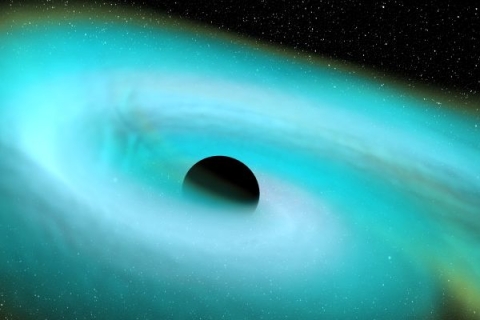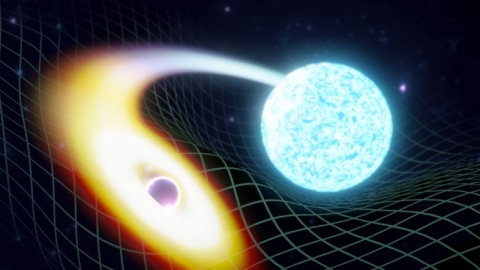

Gravitational wave experts from the University have observed the merger of a neutron star and black hole
28 June 2021
6 min read
New Source of Gravitational Waves Discovered
For the first time, scientists have picked up the ripples in space-time caused by the death spiral of two celestial juggernauts – a neutron star and a black hole.
Scientists picked up the reverberations from these two objects using a global network of gravitational wave detectors – the most sensitive scientific instruments ever built.
This brand new source of gravitational waves was detected by an international team of scientists, including experts from the University of Portsmouth.
Echoes in space-time
Gravitational waves are produced when celestial objects collide and the ensuing energy creates ripples in the fabric of space-time which carry all the way to the detectors we have here on Earth.
On 5 January 2020, the Advanced LIGO detector in Louisiana in the US and the Advanced Virgo detector in Italy, observed gravitational waves from this entirely new type of astronomical system.
LIGO and Virgo picked up the final throes of the death spiral between a neutron star and a black hole as they circled ever closer and merged together.
Remarkably, just days later, a second signal was picked up by Virgo and both ALIGO detectors – in Louisiana and Washington state – again coming from the final orbits and smashing together of another neutron star and black hole pair.
This is the first time scientists have seen gravitational waves from a neutron star and a black hole. Previous gravitational wave detections have spotted black holes colliding, and neutron stars merging – but not one of each.
Dr Ian Harry from the University’s Institute of Cosmology and Gravitation said: “These are the first clear observations of systems containing a neutron star and a black hole. Such systems have long been conjectured but now we know for sure that they exist.
These are some of the most interesting and extreme objects in the Universe and now we can begin to understand how often these types of objects merge together.”

Artistic rendition of a Black Hole merging with a Neutron Star. Image credit: LIGO-India/ Soheb Mandhai
The role of the UK
The UK has contributed greatly to the field of gravitational wave astronomy, from helping to design and build the incredibly sensitive detectors to continuing to search the universe for these signals.
Experts from the University of Portsmouth developed, maintained and run the search algorithm to observe the mergers of neutron stars and black holes as they happen.
Dr Harry said: “Portsmouth researchers developed and ran the "PyCBC" search algorithm used in this work to observe the merger on the 15 January 2020 within minutes of the event occurring. This algorithm was also used to definitively establish the astrophysical origin of this signal."
Proving a theory
For several years, since the first ever direct detection of gravitational waves in 2015, astronomers have predicted that this type of system – a black hole and neutron star merger – could exist, but without any compelling observational evidence.
Now that gravitational wave scientists have finally witnessed the existence of this new type of system, their detection will bring important new clues about how black holes and neutron stars form.
What comes next?
When gravitational waves are detected, astronomers can point their telescopes to look deep into space searching for an accompanying signal in the form of light. Such a light signal was observed in 2017 when LIGO and Virgo observed two neutron stars colliding for the very first time – and could also occur when neutron stars and black holes collide.
No light was observed from these two new events, however, possibly meaning that the neutron stars were ‘swallowed whole’ by their more massive black hole companions.
In future, as the LIGO and Virgo detectors are made even more sensitive, the team hope to detect many more neutron star black hole collisions, including cases where the black hole tearing apart the neutron star is observed in both gravitational-waves and light helping scientists to find out more about what neutron stars are made of.
Dr Harry said: “We will observe many more neutron stars colliding with black holes in the coming years as our observatories continue to improve. This will allow us to understand the mechanisms by which such systems form, study the behaviour of matter under the most extreme conditions and potentially search for deviations in Einstein's theory of gravity.”
The UK’s contribution to the collaborations is funded by the Science and Technology Facilities Council.
